Non-Sporting Dog Breeds is the group from which many pet dogs are selected.
These breeds may well have performed some task in the past, but today, they are now the dogs whose sole purpose in life is to be a companion to their owners.
1. Bulldog

Bulldog At A Glance:
- Height: 31-40cm
- Weight: Dog: 22.5-25kg
- Coat: Short, smooth, close and finely textured
- Color: Uniform color or with black mask or muzzle; reds, red brindle, piebald.
- Lifespan: 8-10 years
The Bulldog’s proud ancestry can be traced back to the Molossus, the fighting dog named after an ancient Greek tribe, the Molossi.
As its name suggests, it was bred to bait bulls.
According to one story, this “sport” commenced in Britain in 1204, when Lord Stamford of Lincolnshire in England was greatly amused by the sight of some butchers dogs tormenting a bull.
This gave his Lordship the idea of providing a field in which bull-baiting tournaments might take place on condition that the butcher would provide one bull a year for the “sport.”
Later, pits were set up in various parts of Britain where dogs would also fight other dogs.
When bull-baiting became illegal in 1835, the Bulldog was in danger of extinction.
Fortunately, Mr. Bill George continued to breed Bulldogs, and, in 1875, the first specialist club for the breed was formed, known as the Bulldog Club Incorporated.
This was followed in 1891 by the London Bulldog Society, which still holds its annual meeting at Crufts Dog Show.
Despite its fearsome appearance, the Bulldog is now a gentle, good-natured dog. It adores children and makes a delightful pet.
The only grooming it requires is a daily run through with a stiff brush and a rub-down. Care must be taken that it is not over-exerted in hot weather.
2. French Bulldog

French Bulldog At A Glance:
- Height: 30cm
- Weight: 12.5kg
- Coat: Short, smooth, close, and finely textured
- Color: brindle, piebald or fawn
- Lifespan: 10-14 years
The French Bulldog is obviously a descendant of small bulldogs, but it is not known whether these were British dog breeds taken to France by Nottingham lace workers in the 19th century or dogs imported to France from Spain.
Small English Bulldog ancestry is generally accepted, despite the discovery of an ancient bronze plaque of a dog bearing an unmistakable likeness to the French Bulldog and inscribed: “Dogue de Burgos, Espana 1625.”
This breed is a popular, good-natured, affectionate, and courageous, and usually gets on well with children and other pets.
Owners must become accustomed to its gentle snuffling, and must be aware that this flat-nosed breed should not be exercised in hot weather.
The “Frenchie” is easy to groom, requiring just a daily brush and a rub-down with a silk handkerchief, or piece of toweling, to make its coat shine. The facial creases should be lubricated to prevent soreness. It’s also important to clean tail pockets frequently to prevent infections as well as other french bulldog tail problems.
3. Boston Terrier
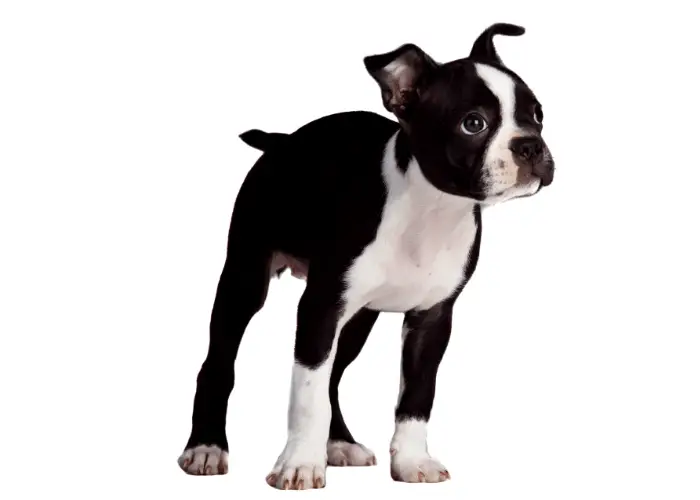
Boston Terrier At A Glance:
- Height: 38-43cm
- Weight: Divided by classes: Lightweight: 7kg; Middleweight: 9kg Heavyweight: under 25 lb (11.5kg)
- Coat: Short and smooth
- Color: Brindle with white markings, black with white markings, but brindle with white markings preferred
- Lifespan: 13-15 years
The Boston Terrier, formerly the American Bull Terrier, derives from a crossbred Bulldog/Terrier that was imported into the United States from Britain in 1865.
Barnard’s Tom, the first example of the breed with the desired screw tail, was bred in Boston, Massachusetts, and registered with the American Kennel Club in 1893.
The breed takes its name from the city where it was developed. The Boston Terrier is a lively, intelligent dog and a loving pet. It is easy to look after and requires little grooming.
4. Dalmatian

Dalmatian At A Glance:
- Height: 47.5-58.8cm
- Weight: 22.5-25kg
- Coat: Short, fine, dense and close; sleek and glossy in appearance
- Color: Pure white ground color with round and well-defined black or liver brown spots, as evenly distributed as possible; spots on extremities smaller than those on the body.
- Lifespan: 10-13 years
The Dalmatian is named after Dalmatia on the Adriatic coast, but it is in Britain that the modern breed became well established.
Heads would turn as a carriage of the British aristocracy went by with an elegant Dalmatian trotting alongside the horses or when they are being used as firedogs.
Although already popular in Britain, the Dalmatian’s registrations doubled following the filming in 1959 of Dodie Smith’s book, 101 Dalmatians.
The breed’s intelligence, friendly character and elegant appearance have made it popular as a pet and show dog worldwide.
This affectionate and energetic dog also requires plenty of exercise.
5. Schipperke

Schipperke At A Glance
- Height: 27.5-32.5cm
- Weight: 5.5-8kg
- Coat: Abundant and dense, with longer hair on the neck, shoulders, chest, and backs of rear legs
- Color: Black, but the undercoat can be slightly lighter; other solid colors are permissible outside the US
- Lifespan: 13-15 years
The Schipperke originated in Belgium but is often thought to be a Dutch dog, a confusion that may have arisen because the Netherlands and Belgium are relatively modern countries.
The breed is thought by some to be 200 years old, although no records exist to prove this.
It may have been established as long ago as the mid-1500s, because of a story that two black dogs without tails rescued Prince William of Orange from an assassin.
Differences of opinion also exist on the breed’s ancestry.
Some think it evolved from early northern spitz dogs, while others consider it a descendant of a now-extinct Belgian sheepdog.
The Schipperke was once the most popular house pet and watchdog in Belgium.
Traditionally, its job was to guard canal barges when they were tied up for the night, and it was this task that earned the breed its name.
Schipperke is Flemish for “little captain,” and has also been translated as “little skipper,” “little Boatman,” and even “little corporal.”
This breed was first seen in 1880.
It was recognized by the Royal Schipperke Club of Brussels in 1886, and given official standard recognition in 1904.
The Schipperke is an affectionate smart small dog that is good with children, usually with a long lifespan, and an excellent watchdog.
It is said that this dog can walk up to 10km a day without getting exhausted!
It should be housed indoors rather than in a kennel, and its coat needs very little attention.
6. Keeshond

Keeshond At A Glance
- Height: 45.5cm
- Weight: 25-29.5kg
- Coat: Long and straight with the hairs standing out; a dense ruff over the neck
- Color: A mixture of gray, black, and cream; pale undercoat
- Lifespan: 13-15 years
The Keeshond (pronounced “kayshond,” plural Keeshunden) has been known as the Fik, Foxdog, Dutch Barge Dog, and even as the Overweight Pomeranian in Victorian England.
Its modern name was taken from a dog owned by the 18th-century Dutchman, Kees de Gyselaer.
It became popular in Holland as the companion of bargees and as a watchdog.
The FCI has been reluctant to accept the standard that has been drawn up for the breed, believing that the Keeshond is identical to the German Wolfspitz.
Good-natured with a long lifespan, the Keeshond tends to be a devoted one-person dog. It requires daily grooming using a stiff brush, and a fair amount of exercise.
7. Finnish Spitz
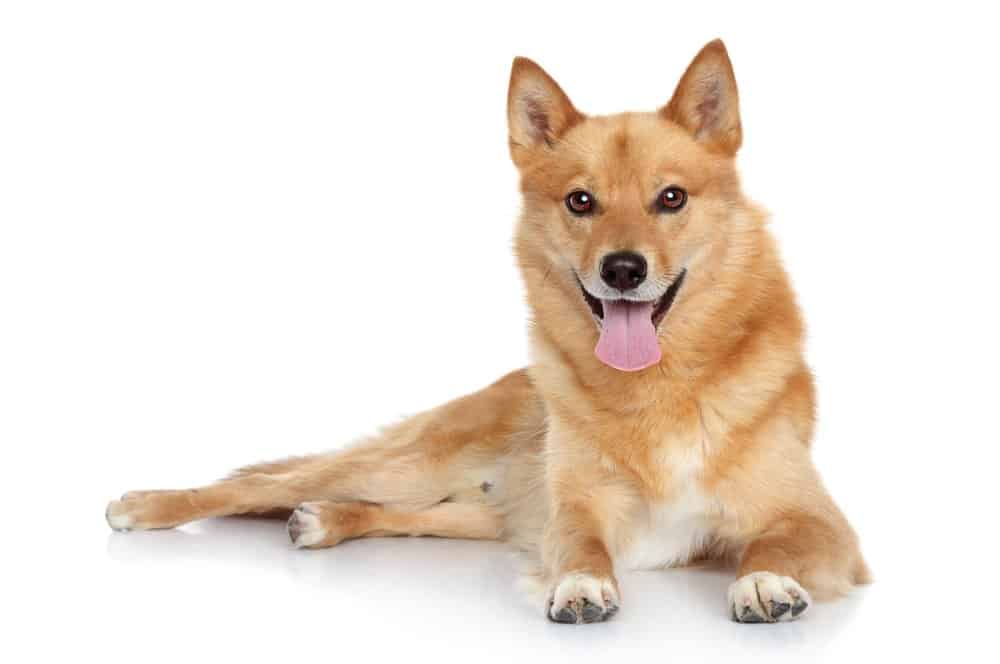
Finnish Spitz At A Glance:
- Height: 43-50cm
- Weight: 11.5-16kg
- Coat: Short and close on head and front of legs, longer on body and back of legs, semi-erect and stiff on neck and back
- Color: Reddish-brown or red-gold on back, preferably bright; lighter shades permissible on the underside
- Lifespan: 12-14 years
The Finnish Spitz is known in its native land as Suomenpystykorva, which means “cock-eared dog.”
Related to the Russian Laika, the breed originated in the eastern area of Finland.
It is the national dog of Finland, and is mentioned in a number of heroic Finnish songs.
It was once used by Lapp hunters to track elk and polar bears, but is now popular throughout Scandinavia for hunting grouse and other game birds.
It was introduced and pioneered in Britain in the 1920s by the late Lady Kitty Ritson, who is responsible for the breed’s nickname of Finkie.
While still a favorite with hunters in Scandinavia, the Finnish Spitz is kept almost entirely as a companion and show dog elsewhere.
It is appreciated as a faithful and home-loving pet that is good with children and adept at guarding. It requires plenty of exercise and daily brushing.
8. Lhasa Apso

Lhasa Apso At A Glance:
- Height: 25.5cm
- Weight: 7-8kg
- Coat: Top coat long, heavy, straight, and hard, not woolly or silky; moderate undercoat
- Color: Solid golden, sandy, honey, dark grizzle, slate, or smoke; black parti-color, white, or brown
- Lifespan: 12-14 years
The Lhasa Apso originated in Tibet and also known as the Tibetan Apso.
It is a small, indoor watchdog, possibly bred in the distant past from the Tibetan Mastiff.
The word “Apso” means goat-like, and the dog may have been so named because its coat resembled that of the goats kept by Tibetan herders.
The breed was very highly regarded in its native land, and kept in temples and palaces.
The Lhasa is often confused with the Shih Tzu from western China, but there are a number of physical differences between them, including the fact that the Lhasa Apso has a longer nose and its nose-tip is placed lower.
However, in the past, there seems to have been some interbreeding between them outside their native lands.
The Lhasa Apso is happy, usually long-lived, adaptable, and good with children. It enjoys a good romp outdoors, but it does require careful daily grooming of its long coat.
9. German Spitz

German Spitz At A Glance:
- Height: Small: 23-28cm; Standard: 29-35.5cm
- Weight: Small: 3kg; Standard: 11.5kg
- Coat: Soft, woolly undercoat and long, dense, straight outer coat
- Color: All solid color varieties
- Lifespan: 13-15 years
The only difference between the Small German Spitz and Standard German Spitz is size.
Both are smaller versions of the Great German Spitz or Wolfspitz.
Although it is difficult to pinpoint the origin of spitz dogs, they probably come from Scandinavia and were taken to other countries by the Vikings.
Spitz dogs were known as early as 1700 when white specimens were said to be kept in Pomerania and black ones In Wurttemberg.
Some of the smaller varieties of the white spitz bred in Pomerania became known and established under the name Pomeranian.
This active, intelligent dog is independent, yet devotion to its human family is a breed characteristic.
The German Spitz a.k.a. American Eskimo Dog can adapt to life in the town or country, and needs vigorous daily brushing and an average amount of exercise. If r-unchecked, the breed does have a tendency to yap.
10. Chow Chow
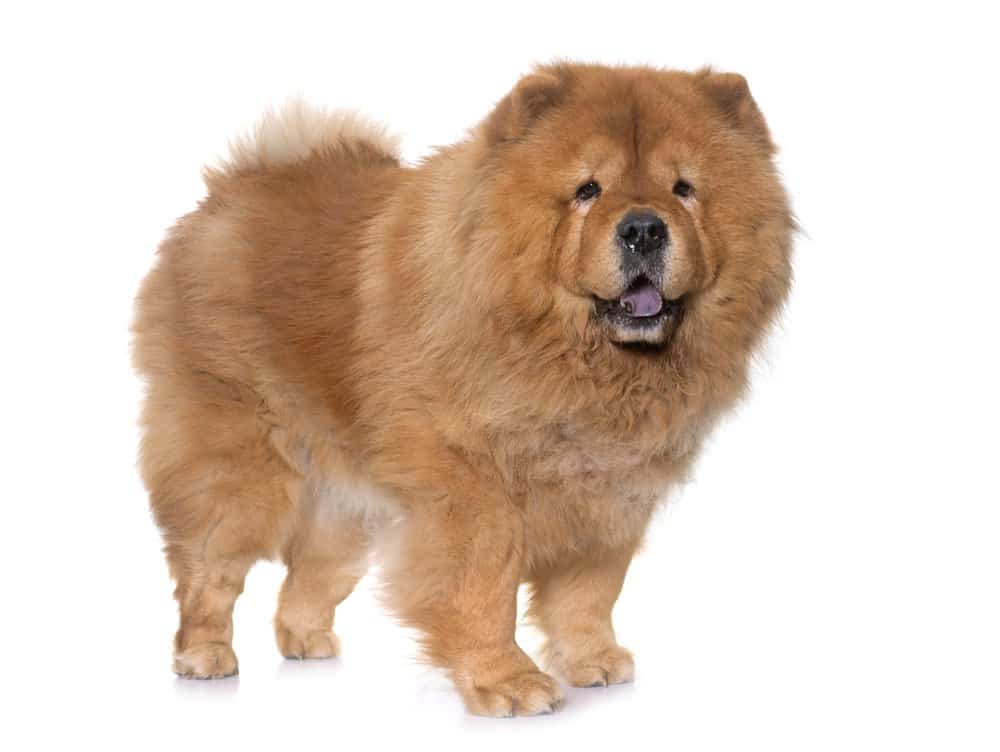
Chow Chow At Glance:
- Height: 48-56cm
- Weight: 20-31.5kg
- Coat: Rough, abundant, dense, and coarse, with a pronounced ruff around head and neck, and feathering on tail; or smooth, dense, and hard, with no ruff or feathering
- Color: Solid black, red, blue, fawn, or cream; blue-black tongue
- Lifespan: 9-15 years
The Chow Chow is the only dog with a black tongue, a characteristic it shares with some small bears.
This lion-like member of the spitz family has been known in its native China for more than 2,000 years.
It was bred variously for its flesh, its fur, and as a hunter of game, its name possibly deriving from the Chinese Choo Hunting Dog.
The Chow Chow is said to have been the original “Mastiff” of the Tibetan Lama, and is also referred to in early Chinese writings as the Tartar Dog and the Dog of the Barbarians.
The first Chow Chow was imported into Britain in 1760 and exhibited in a zoo.
In 1895, the Chow Chow Club was formed there, and in 1905 the first member of the breed was exported from Britain to America.
This was Mrs. Garnett Botfield’s Chinese Chum that, in 1905, became the first American Chow Chow champion.
In 1936, Mrs. V.A. Mawnooch’s Champion Choonam Hung Kwong won the Best in Show title at Crufts Dog Show.
He was the recipient of 44 British Challenge certificates and was valued at the then immense sum of US$8,400.
The Chow Chow has always had a reputation for ferocity, but, it is unlikely to attack unless provoked.
It is a faithful, odor-free dog that makes a good pet, prefers to look to one person as its master and needs firm but gentle handling.
A good daily walk will suffice, but the full coat requires considerable attention with a brushing.
11. Shiba Inu

Shiba Inu At A Glance:
- Height: 37.5-40cm
- Weight: 9-13.5kg
- Coat: Harsh and straight
- Color: Red, salt and pepper, black, black and tan, or white
- Lifespan: 12-15 years
The Shiba Inu is an ancient Japanese dog breed associated with the Prefectures of Gifu, Toyama, and Nagano in central Japan.
The name, in fact, means “little dog” in the Nagano dialect.
Remains of a dog of this type were found in ruins dating back to the Roman era (500 BC).
The Shiba Inu has, in recent years, become a firm favorite of exhibitors, following closely on the heels of the Japanese Akita onto the international scene.
It is an excellent bird dog, guard, and hunter of small game.
The Shiba is an affectionate, friendly, and sensitive dog that makes a fine pet as well as a show dog and/or hunter. It needs a fair amount of exercise and a good daily brushing.
Thinking of getting this dog?
Please read our article about Shiba Inu pros and cons
12. Tibetan Spaniel
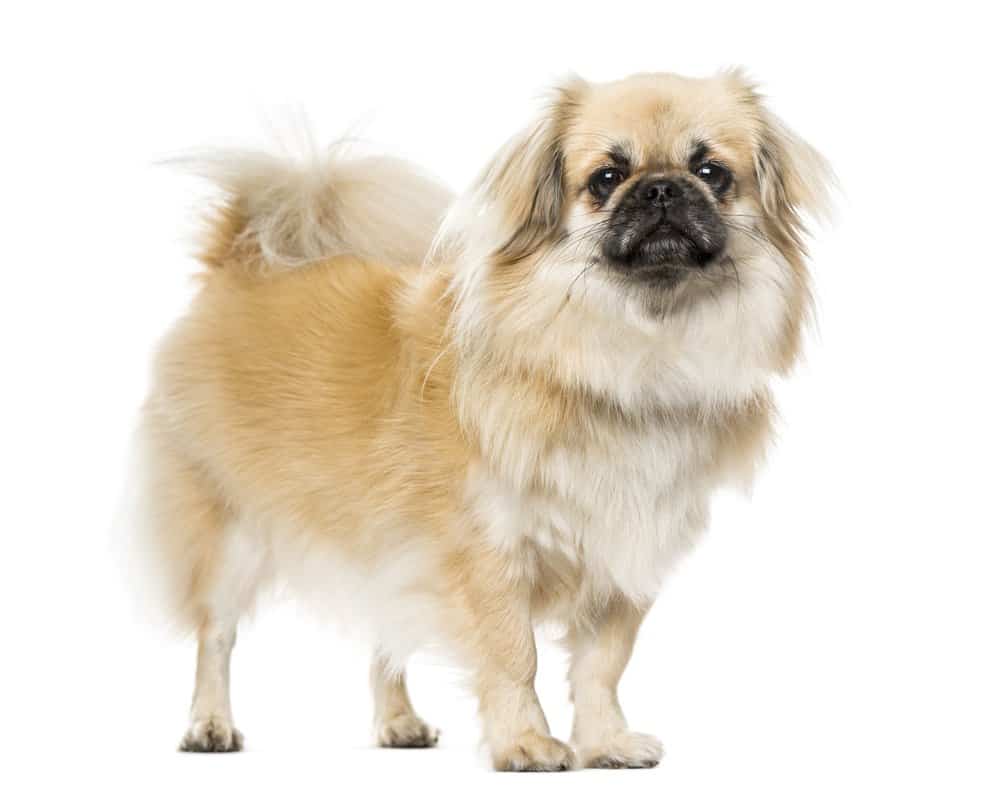
Tibetan Spaniel At A Glance:
- Height: 25.5cm
- Weight: 4-7kg
- Coat: Moderately long and silky in texture; shorter on the face and fronts of legs; feathering on ears, backs of legs, and tail
Color: All solid colors and mixtures - Lifespan: 12-15 years
Despite its name, this breed is nor related to the spaniels and is not known to have been used as a hunting companion or gundog.
The Tibetan Spaniel is thought to have been in existence long before the history of Tibet started to be chronicled in the 7th century, and its origins are therefore obscure.
The exchange of dogs between Tibet and China in ancient times means that Chinese dogs, such as the Shih Tzu or Pekingese-like dogs, could have contributed to its bloodlines.
It has also been said that the Tibetan Spaniel has crossed with the Pug to bring about the Pekingese.
[ Check Out Our Pug crossed with Jack Russell Article ]
The Tibetan-Spaniel was a favorite with monks, and it is said that it turned the prayer wheel of Tibetans.
It is also said that it was used by humans for warmth. This charming, good-natured dog is rarely seen outside the show ring.
It is intelligent, good with children, and makes a splendid housepet. It is energetic and enjoys a good romp, and its coat needs regular grooming.
13. Tibetan Terrier
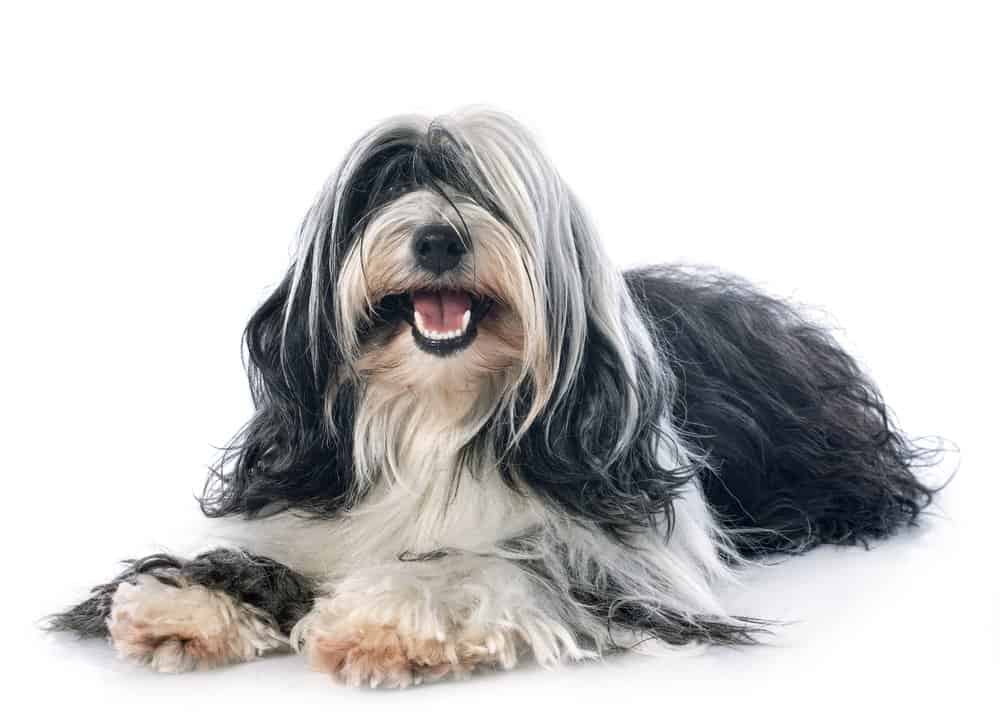
Tibetan Terrier At A Glance:
- Height: 35.5-40.5cm
- Weight: 9-11 kg
- Coat: Soft, woolly undercoat; long, fine outer coat that can be straight or wavy
- Color: Any color or combination of colors
- Lifespan: 12-15 years
The Tibetan Terrier is not really a terrier at all, having no history of going to earth, but resembles a small Old English Sheepdog.
Like other little Tibetan dog breeds, it appears not to have been bred for any purpose other than that of a companion dog.
Of ancient lineage, the Tibetan Terrier is said to have been bred in Tibetan monasteries, and specimens used to be presented to travelers as mascots and to bring luck.
The breed was included in the Tibetan Breeds Association register in 1934 and now has its own standard.
It is loyal, sturdy, a good walker, and devoted to its owners and to children, but a little apprehensive of strangers. Its long coat needs regular attention.
14.Bichon Frise
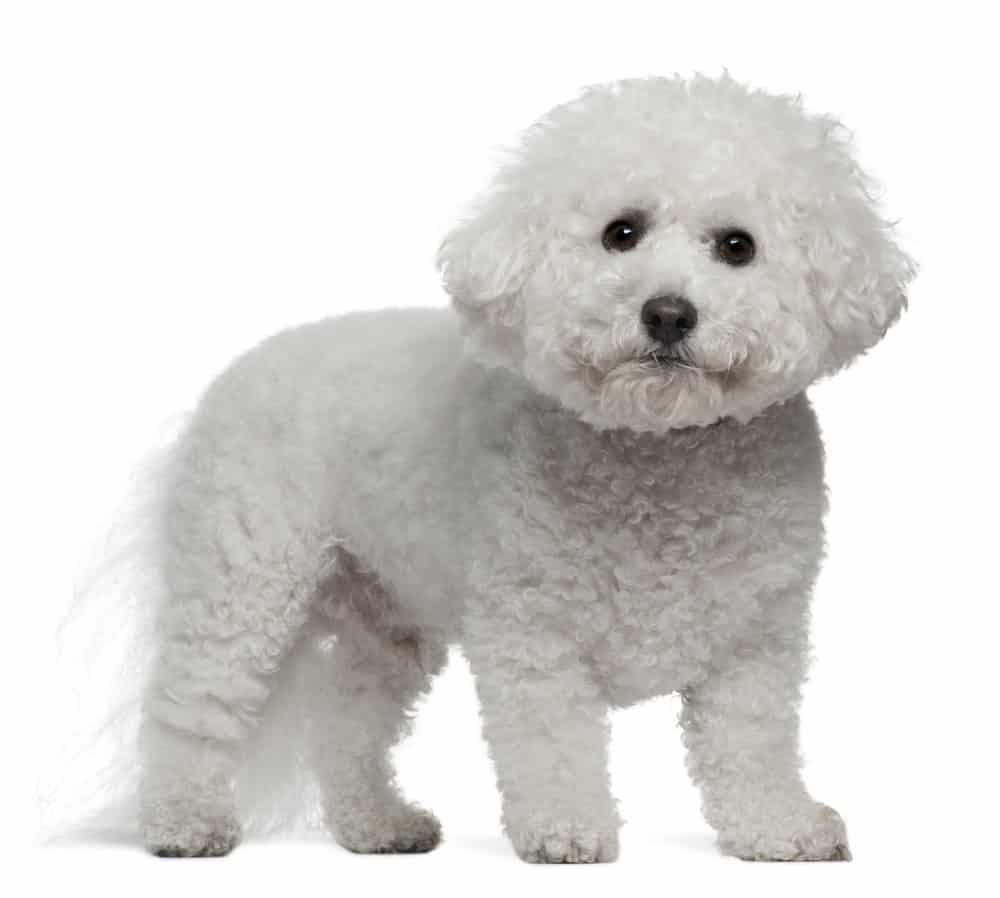
Bichon Frise At A Glance:
- Height: 23-28cm
- Weight: 3-5kg
- Coat: Long and loosely curling
- Color: White, cream, or apricot markings permissible up to 18 months; dark skin desirable
- Lifespan: 12-15 years
The word “bichon” is often used collectively to describe small, white dogs.
The Bichon Frise or Bichon a Poil Frise (curly-haired Bichon), or Tenerife Dog, is reputed to have been introduced to Tenerife in the Canary Islands by sailors in the 14th century.
However, like the Poodle, it is thought to be a descendant of the French water dog, the Barbet, and its name comes from the diminutive, barbichon.
Similar in appearance to the Miniature Poodle, the Bichon Frise is recognized internationally as a Franco-Belgian breed.
Happy, friendly, and lively, this breed makes an attractive and cuddly small pet that will enjoy as much exercise as most owners can provide.
However, its long curly coat, resembling a powder puff, means that it is not the choice for anyone who hates grooming.
15. Standard Poodle
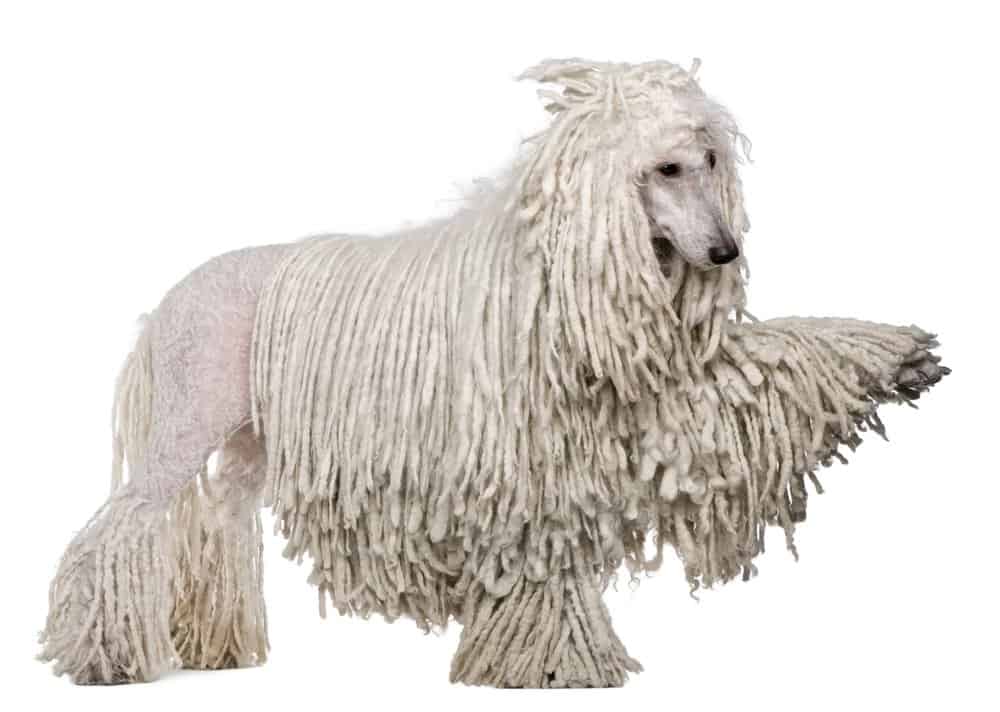
Standard Poodle At A Glance:
- Height: 38cm
- Weight: 20-31.5kg
- Coat: Curly: harsh texture and dense throughout Corded: hanging in tight cords of varying lengths, but longer on mane, body, head, and ears
- Color: Black, blue, gray, silver, brown
- Lifespan: 12-15 years
Known in France as the Caniche, the Poodle was certainly favored by the French Queen Marie Antoinette.
However, it originated in Germany as a water retriever or Pudel in German.
It resembles the Irish Water Spaniel, and both share common ancestors with the French Barbet.
Its intelligence and eagerness to learn means that it can compete in obedience trials and as a circus dog.
This happy, lively clog makes a good pet, enjoying a fair amount of exercise. It is also a fine show dog if intensely trained.
While it is shown in the lion clip, many pet owners prefer the lamb clip (with hair uniform length).
Whatever style you choose, you will need to use a wire-pin pneumatic brush and a wide-toothed metal comb for daily grooming.
16. Miniature Poodle
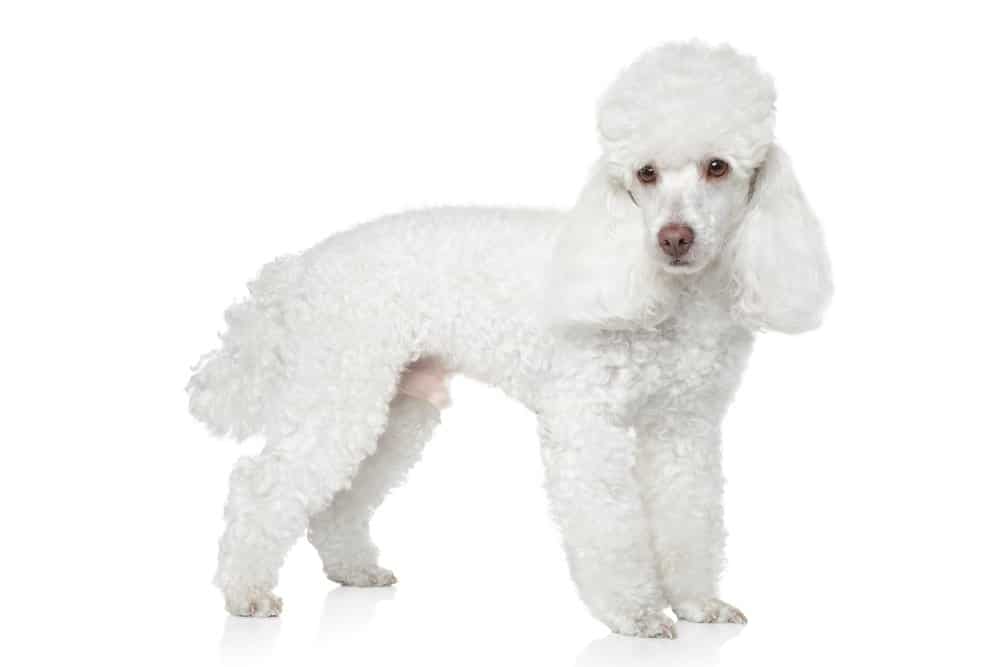
Miniature Poodle At A Glance:
- Height: 25-37.5cm
- Weight: 6-8kg
- Coat: Naturally harsh, and can be curly or corded
- Color: All solid colors; clear colors preferred
- Lifespan: 12-15 years
The Miniature Poodle was bred down from the Standard, presumably by using the smaller specimens.
During the 1950s, it became the most popular breed in many countries.
While there are those who say that it is not a proper dog at all, but, the Miniature Poodle remains a favorite.
The Miniature Poodle has the same show standard and characteristics as the larger and smaller breeds, except in the matter of the size of course.
17. Sharpei
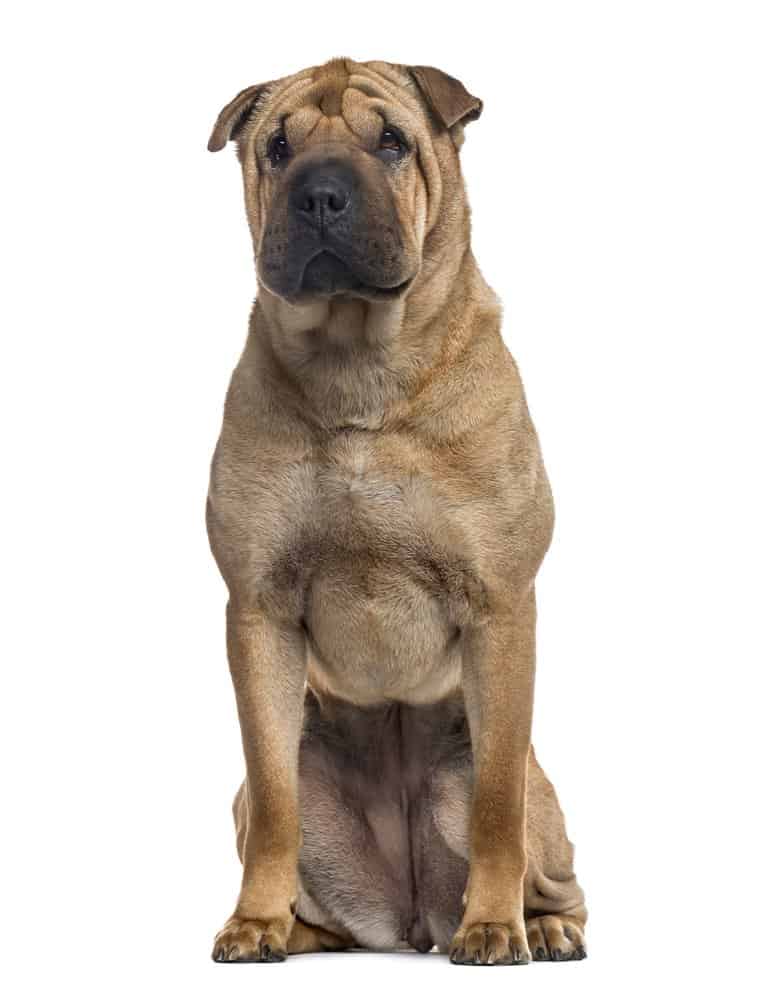
Sharpei At A Glance:
- Height: 46-51cm
- Weight: 18-25kg
- Coat: Short, straight, and bristly; no undercoat
- Color: Solid colors only: black, red, light or dark fawn, or cream
- Lifespan: 9-11 years
There is a resemblance of the Shar-Pei or Chinese Fighting Dog dating back to the Han Dynasty (206 BC-AD 220), and it has been suggested that this loose-skinned breed may have originated in Tibet or China’s Northern Province some 2,000 years ago.
The Shar-Pei was used to herd flocks and hunt wild boar in China. It was also matched against other dogs in strength trials, although its nature is so affable that it may have had to be provoked to do so with the aid of drugs.
It is not long since the Shar-Pei had the distinction of being the rarest dog in the world, but now it is drawing good entries in the show ring.
A very affectionate dog with a frowning expression, the Shar-Pei is calm, independent, and devoted. Its coat is never trimmed, and it needs a reasonable amount of exercise.
18. Japanese Spitz
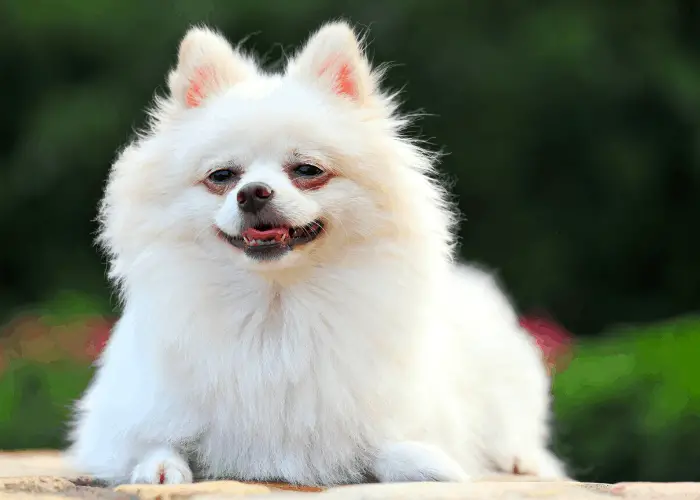
Japanese Spitz At A Glance:
- Height: 30-36cm
- Weight: 6kg
- Coat: Straight, dense, stand-off outer coat; thick, short, dense undercoat
- Color: Pure white
- Lifespan: 10-16 years
The Japanese Spitz shares a common ancestry with the Nordic Spitz.
It is about half the size of the Samoyed, and is also closely related to the German Spitz and Pomeranian.
Its ancestors are said to have been taken to Japan in the ships of traders many years ago, and there the breed was developed in isolation.
The breed is a family favorite in Japan and became known not just in Asia internationally as a popular show dog.
The Japanese Spitz is a beautiful alert, intelligent, and lively dog. Loyal to its owners and doesn’t trust strangers which makes it a fine small guard dog.
The breed requires daily brushing, also enjoys a fair amount of exercise.
19. Toy Poodle
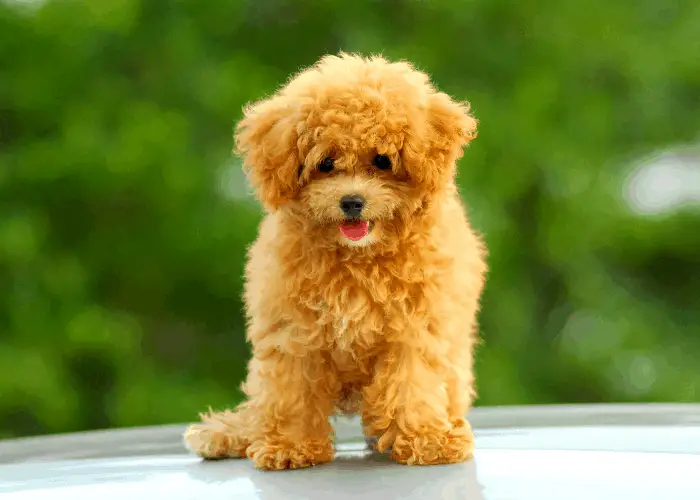
Toy Poodle At A Glance:
- Height: 25cm
- Weight: 4.5 kg
- Coat: Very profuse and dense with good, harsh texture; curly or corded
- Color: All solid colors; brown and cafe-au-lait have liver noses, eye rims, and lips; all others have black noses, eye rims, and lips
- Lifespan: 12-15 years
The Toy Poodle is a descendant of the Miniature Poodle.
The smaller specimens were so much in demand that, by the middle of the 1950s, the UK Kennel Club agreed to open a separate register for them. (Some kennel clubs don’t consider this dog as one of non-sporting dog breeds
These are the least robust of the three varieties, however, so it is essential to select from the sound stock.
The Toy Poodle has the same characteristics and show standard as its larger counterparts, except in size.
It is happy and good-tempered and makes a delightful pet that is ideal for the apartment dweller who nonetheless enjoys a canine companion.

